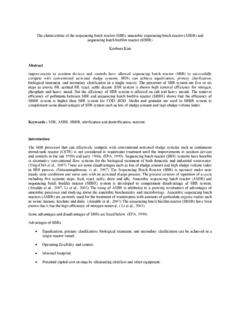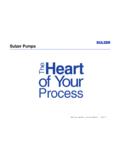Transcription of Waste Stabilization Ponds for Waste Water …
1 Waste Stabilization Ponds for Waste Water treatment , anaerobic Pond By Fernando J. Trevino Quiroga Abstract Waste Stabilization Ponds (WSP) have been used world-wide over the last 50 years for municipal and industrial wastewater. The Waste Water treatment system has been accepted and used to change the physical, chemical, or biological character of the Waste . This article presents the characteristics, parameters, and examples of the Waste Stabilization Ponds all over the world. This work was based on review of previous research, experiments and articles that discuss how the treatment is of great importance to humanity. Parasite removals were reduced 98% after using the treatment in several countries with 100 beds.
2 There will be comparison and description of the WSPs in USA, Canada, Europe, and former Soviet Union. Experiments have shown how the treatment is effective due to the elimination of Waste in Water , improving Water quality by a 95%. There are several types of Waste Stabilization Ponds . They are: anaerobic , facultative, and maturation Ponds . Approximately half of the solid Waste left after primary treatment settles out in the oxidation Ponds . The growth of algae in the oxidation Ponds help Water quality by increasing the oxygen and consuming Nitrogen and Phosphorous, two common nutrients that area found in Waste Water . Some pre-requisites may be used for efficiency of the process. Keywords: WSP; parameters; Waste Stabilization Ponds ; characteristics; algae; pre-requisites Introduction The Waste Stabilization can be classified by considering the type(s) of biological activity occurring in a pond.
3 Three types of Ponds may be distinguished: anaerobic Ponds , facultative, and maturation Ponds . Figure 1. Algal-bacterial mutualism in facultative and maturation Ponds . (Mara, 1998). anaerobic Ponds are deep Waste Water treatment Ponds that exclude oxygen and encourage the growth of algae, with bacteria to help break down the effluent. The anaerobic pond acts mostly like an uncovered tank that breaks down the organic matter in the effluent with the use of organisms, releasing methane and carbon dioxide. 23 - 1. The facultative Ponds are divided into two types: primary, which receives raw wastewater;. and secondary, which receives the settled wastewater left over from the first stage. Facultative Ponds are designed for BOD5 removal using algae, which help to produce oxygen to the pond.
4 Finally Maturation Ponds are Ponds that receive the effluent from a facultative pond and its size and number depends on the quality of the bacteria that is released in the effluent. This kind of pond is shallow and shows less vertical stratification than the other types of Ponds . Its Water volume is well oxygenated throughout the day, due to the population of algae. The purpose of this type of pond is to remove pathogens and fecal coliforms by the oxidation process. Maturation Ponds only achieve a small removal BOD5, but they remove more nitrogen and phosphorous than other pond systems. WSPs are most often referred to as oxidation Ponds or lagoons - this is a natural secondary wastewater treatment .
5 The primary treatment takes place in the anaerobic pond, which serves the purpose of removing suspended solids and some of the soluble matter (BOD5). Waste Stabilization pond technology is particularly well suited to countries in tropical and subtropical regions, because the greater amount of sun and higher temperatures contribute to a more efficient removal of Waste . The secondary wastewater treatment is man-made basins and has the ability to stabilize the Waste and reduce the pathogens. WSPs have been used all around the world because of the efficiency to reduce the Waste with the use of microorganisms, although its effectiveness is affected by the different climatic conditions in different locations.
6 This treatment is most appropriate for Waste Water treatment and is followed by a microbiological and chemical quality guidelines with a low cost, minimal operational, and maintenance requirements. Much of the cost of Waste Water treatment is expensive compared with the natural treatments. Waste Stabilization Ponds (WSP) are now regarded as the method of first choice for the treatment of wastewater in many parts of the world (Boutin et al., 1987; Bucksteeg, 1987). In Europe, for example, WSP are widely used for small rural communities (approximately up to 2000. population, however larger systems exist in the Mediterranean region of France, as well as Spain and Portugal) (Boutin et al., 1987; Bucksteeg, 1987).
7 The effluents of these Ponds have many uses such as usage in agriculture. anaerobic Ponds anaerobic Ponds are deep shallow Ponds that exclude oxygen and encourage the growth of bacteria, which break down the effluent. WSPs are single-stage, continuous-flow, anaerobic reactors, operating at ambient temperatures and low volumetric organic loadings. These Ponds are used as a pretreatment for BOD, SS, and COD removal. The wastewater that comes in is domestic and industrial wastewater. The anaerobic pond can be described as an uncovered septic tank. The anaerobic bacteria break down the organic matter in the effluent, which release carbon dioxide and methane. The sludge is taken to the bottom of the pond by the sedimentation process.
8 These types of Ponds are usually 2-5 meters deep and receive an organic load of >100. g BOD/m d equivalent to >3000 kg/ha/d for a depth of 3 meters. (Ramadan & Ponce, 1999). Some advantages of this treatment are that it's simple, has a relatively low cost, and it's good for pathogen removal. However, one disadvantage is that it requires more land than other particular treatments. anaerobic Ponds do not contain algae like the rest of the Ponds , although it occasionally contains a thin film of Chlamydomonas on the surface of the pond. These Ponds work extremely well in warm climates, with the removal of BOD ranging from 60-85% in a very short retention time (Alexiou & Mara, 2003). The WSPs are normally placed ahead of a treatment line involving secondary facultative and maturation Ponds .
9 treatment mechanisms involve the removal of suspended solids by the sedimentation process. Typically, domestic wastewater particulates BOD in a range of 40-60%. (Alexiou & Mara, 2003). anaerobic Ponds reduce microorganisms by sludge formation and the release of ammonia into the air. This treatment also serves to: 23 - 2. Separate out the solids form dissolved material as solids settle as bottom sludge. Breakdown biodegradable organic material Allow partially treated effluent to pass out Store undigested material and non-degradable solids as bottom sludge Dissolve further organic material. The formation of odor and accumulation of residue has to do with the kind of Waste that the pond is treating. This kind of concentration and volumetric load con be produced by sulphate (SO4), which is reduced to hydrogen sulphide (H2S) under the anaerobic conditions.
10 The best solution for this case is to follow the recommendations of Waste loadings. A small amount of sulphide is beneficial as it reacts with the heavy metals to form insoluble metal sulphides (Mara et al. 1992). Waste Stabilization Pond design The design criteria of the WSP are based on the maximum and minimum BOD volumetric loading. It is suggested that for high temperatures (>20 C) and a hydraulic retention time of , BOD removal would be 60%. Doubling the retention time would only achieve a 17% increase, with a removal rate of 70% (Mara, 2003). The loadings of BOD/m d, should have a normal range of loading between 100 and 400g, and if the temperature is higher or in the range of 27-30 C, the amount of loading could be greater.








